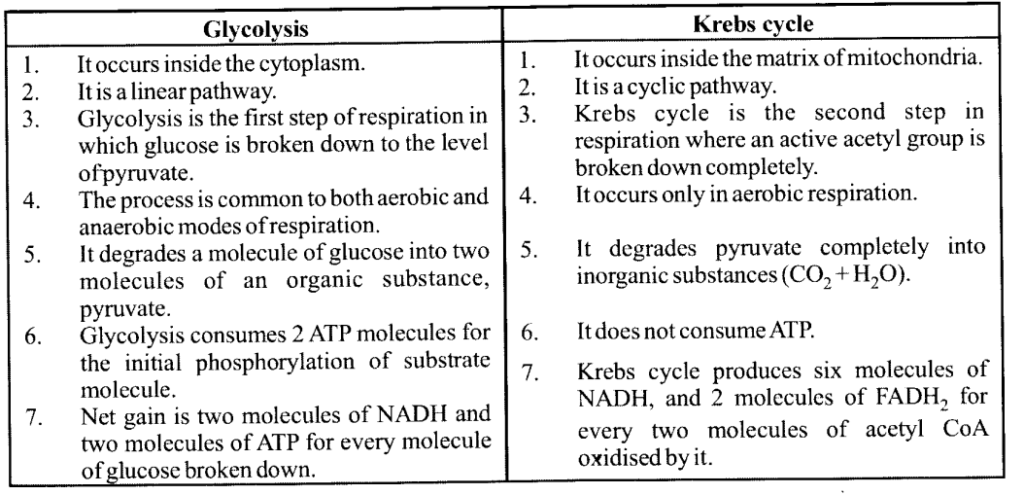NCERT Solved Exercise Questions – Class 11 Biology Chapter 14 Respiration in Plants
14.1 Differentiate between
(a) Respiration and Combustion
(b) Glycolysis and Krebs’ cycle
(c) Aerobic respiration and Fermentation
Ans –
(a) The following are the differences between combustion and respiration.

(b) The following are the differences between Glycolysis and Krebs’ cycle

(c) The following are the differences between Aerobic respiration and Fermentation

14.2. What are respiratory substrates? Name the most common respiratory substrate.
Ans – Organic materials known as respiratory substrates are those that are oxidised during breathing to release energy within living cells.
Carbohydrates, proteins, lipids, and organic acids are the most typical respiratory substrates. Glucose is the most typical respiratory substrate. Hexose monosaccharide is what it is.
14.3. Give the schematic representation of glycolysis?
Ans –

14.4. What are the main steps in aerobic respiration? Where does it take place?
Ans – Pyruvate is moved from the cytoplasm into the mitochondria during aerobic respiration, which happens inside the mitochondria as the end product of glycolysis.
The following are the key moments in aerobic respiration:
1• The total oxidation of pyruvate through the sequential removal of all hydrogen atoms, which results in the formation of three molecules of CO2.
2• The transfer of the electrons that were taken out of the hydrogen atoms to molecular O2 while ATP is also being synthesized.
3• The first process happens in the mitochondria’s matrix, whereas the second one happens on the inner membrane of the organelle.
• After entering the mitochondrial matrix, pyruvate, which is created by the glycolytic degradation of carbohydrates in the cytosol, passes through a complex series of events that are catalysed by pyruvic dehydrogenase to undergo oxidative decarboxylation. NAD+ and Coenzyme A are just two of the coenzymes needed to participate in the processes that pyruvic dehydrogenase catalyses.

During this process, two molecules of pyruvic acid are converted into two molecules of NADH (produced from one glucose molecule during glycolysis).
The Krebs cycle, also known as the tricarboxylic acid cycle, is the next cyclic route that the acetyl CoA enters.
14.5. Give the schematic representation of an overall view of Krebs’ cycle
Ans –

14.6. Explain ETS
Ans – A group of coenzymes and cytochromes that participate in the transfer of electrons from a chemical to its final acceptor is known as an electron transport chain or system (ETS). Participating in the electron transport chain are reduced coenzymes. On the cristae of mitochondria [oxysomes (F0 -F1, particles) situated on the inner surface of the membrane of mitochondria] is where electron transport occurs. NADH dehydrogenase (complex I) oxidises NADH produced during glycolysis and the citric acid cycle, and the electrons are then transferred to ubiquinone. Additionally, succinate dehydrogenase’s action on FADH2 allows ubiquinone to receive reducing equivalents. The oxidation of the reduced ubiquinone is accomplished by the transfer of cytochrome c electrons through the cytochrome Fc, complex.
Between complex III and complex IV, cytochrome c functions as a mobile carrier. Cytochrome c oxidase complex IV is referred to as having two copper centres, cytochromes a and a3, and other components. The electrons are connected to ATP synthase (complex V) for the synthesis of ATP from ADP and Pi when they are shunted across the carriers by complexes I to IV in the electron transport chain. Along with the hydrogen atoms, oxygen serves as the final acceptor of electrons and is reduced to water. Coenzyme I, II, and FAD that have been reduced do not mix with molecular oxygen directly. Only their hydrogen or electrons pass through different substances and arrive at O2 in the end.
Electron carriers are the materials that are beneficial for the transport of electrons. Only electrons travel via the cytochromes (Cyt F1 Cyt c, C2, a, and a3) before arriving at molecule O2. The cytochrome oxidase system is made up of both cytochrome A and A3. In addition to iron, Cyt a3 also contains copper. The protons that were released into the surrounding medium are now taken up by the molecular oxygen that has accepted electrons, creating a molecule of water. The energy that is released is used to create ATP from ADP and Pi.

14.7. Distinguish between the following:
(a) Aerobic respiration and Anaerobic respiration
(b) Glycolysis and Fermentation
(c) Glycolysis and Citric acid Cycle
Ans – (a) The following are some differences between aerobic and anaerobic respiration:

(b) The following are some differences Glycolysis and Fermentation:

(c)The following are some differences between Glycolysis and Citric acid Cycle :

14.8. What are the assumptions made during the calculation of net gain of ATP?
Ans – Calculating the net gain in ATP for each glucose molecule that is oxidised is theoretically possible, but it cannot be done in practise. These calculations can only be performed under the following conditions:
The glycolysis, TCA cycle, and ETS pathways all follow one another in a sequential, ordered pathway, with one substrate producing the next.
the mitochondria, where it is put through oxidative phosphorylation.
The pathway’s intermediates are not used to synthesise any other compounds.
No alternative substrates are entering the pathway at any of the intermediate stages; only glucose is being respired.
These kinds of presumptions, however, are not actually true in a live system; substrates enter the routes and are withdrawn from them as and when necessary; all pathways operate simultaneously and do not occur one after the other; Enzymatic rates are regulated by a number of mechanisms, and ATP is utilised as and when necessary. Therefore, during the aerobic respiration of one glucose molecule, there may be a net gain of 36 ATP molecules.
14.9. Discuss “The respiratory pathway is an amphibolic pathway.”
Ans – The catabolic and anabolic (building up) reactions can both occur along the amphibolic pathway. The respiratory pathway is mostly a catabolic mechanism that supplies energy to power the living system. There are several intermediates produced by the route. A large portion of them serve as starting points for the synthesis of primary and secondary metabolites. In addition to aiding in the Krebs cycle, acetyl CoA serves as a precursor for the production of fatty acids, steroids, terpenes, aromatic compounds, and carotenoids. Ketoglutarate is an organic acid that, upon amination, converts to glutamate, a crucial amino acid. Oxaloacetic acid (OAA) undergoes amination and generates asparate. Glutamate and aspartate are both parts of proteins. Alkaloids and pyrimidines are additional goods. Chlorophyll and cytochromes are produced by succinyl CoA.
Therefore, when utilised as a substrate, fatty acids would first be converted to acetyl CoA before entering the respiratory route. But acetyl CoA would be removed from the respiratory route when the organism needed to synthesise fatty acids. As a result, the respiratory route is involved in both the synthesis and the breakdown of fatty acids. Respiratory intermediates also serve as a connection during the breakdown and synthesis of proteins. Catabolism is the breakdown of biological processes, and anabolism is the synthesis of new ones. It would be preferable to think of the respiratory pathway as an amphibolic pathway rather than a catabolic one because it is engaged in both anabolism and catabolism.
14.10. Define RQ. What is its value for fats?
Ans – The respiratory quotient (RQ) is the proportion of oxygen utilised during respiration to carbon dioxide produced over time. One, zero, more than one, or less than one can be its value.

14.11. What is oxidative phosphorylation?
Ans – The process of oxidative phosphorylation uses energy released during the oxidation of reduced co-enzymes (NADH, FADH2) created during respiration to create energy-dense ATP molecules. ATP synthase is the name of the enzyme needed for this synthesis. It is regarded as the fifth complex in the chain of electron transport. The FT, or head piece of the F0–F1 or elementary particles, is where ATP synthase is found. The inner mitochondrial membrane contains the particles. Only in the presence of a proton gradient with a higher concentration of H+ or protons on the F0 side than the F x side does ATP synthase become active in the formation of ATP.
By pushing proton with the aid of energy released during the transfer of electrons from one carrier to another, a higher proton concentration is created in the outer chamber or outer surface of the inner mitochondrial membrane. Three pairs of protons are pushed to the outer chamber by the transport of electrons from NADH via ETC, whereas two pairs of protons are pushed outside by the transport of electrons from FADH2. The F1 particle becomes an ATP synthase when protons are allowed to flow via the F0 channel. The high energy bond utilised to attach a phosphate radical to ADP uses the energy of the proton gradient. This results in ATP. Three ATP molecules are created when one NADH2 molecule is oxidized, whereas two ATP molecules are created when one FADH2 molecule is oxidized.
14.12. What is the significance of step-wise release of energy in respiration?
Ans –All of the energy included in respiratory substrates is not immediately or completely released into the cell through oxidation within the cell. It is trapped as chemical energy in the form of ATP before being released in a sequence of gradual, stepwise enzyme-controlled processes.
It is crucial to realise that the energy released during respiration during oxidation is not used directly but rather is used to create ATP, which is then broken down whenever (and anywhere) energy is required. Therefore, ATP serves as the cell’s unit of account for energy.
The organisms employ the energy stored in ATP for a variety of energy-intensive operations, and the carbon skeleton created during respiration serves as a precursor for the production of other molecules in the cell.



